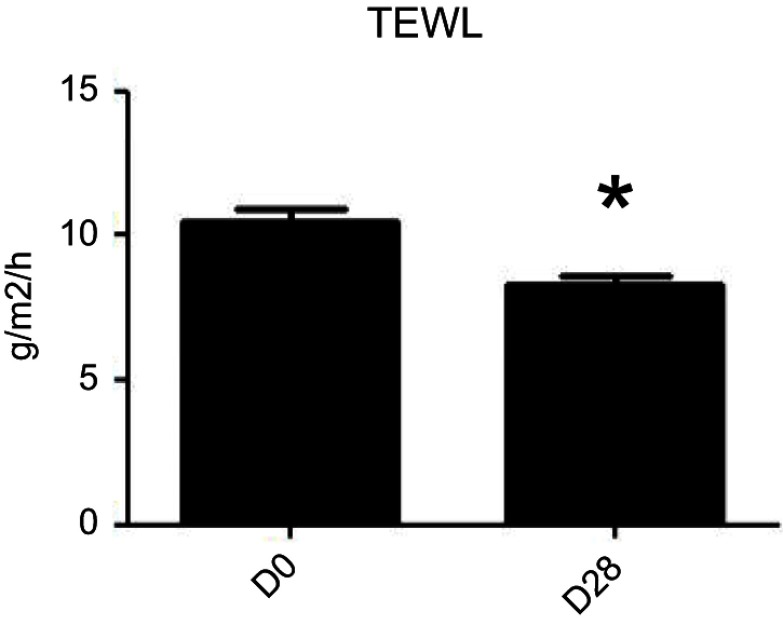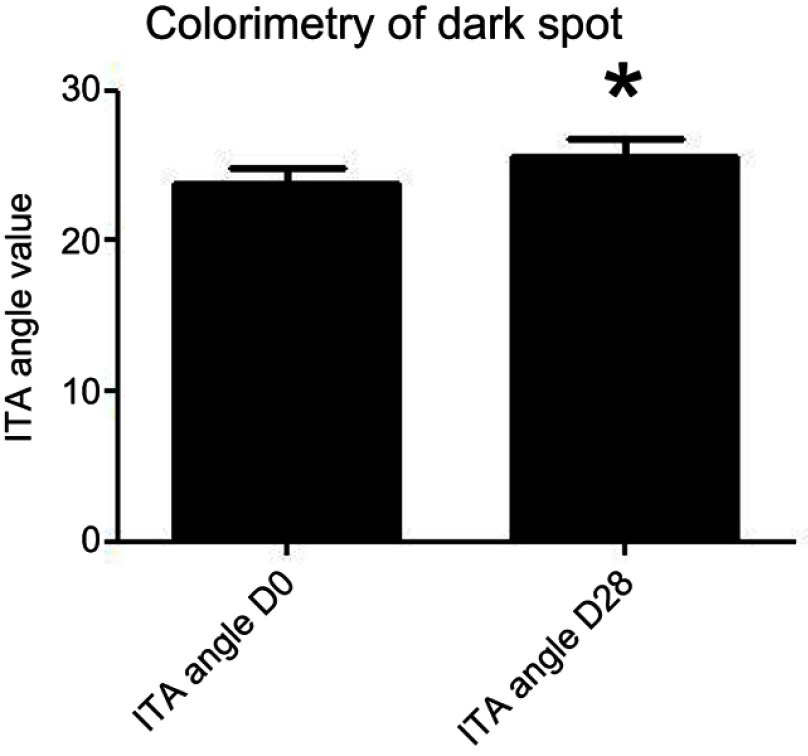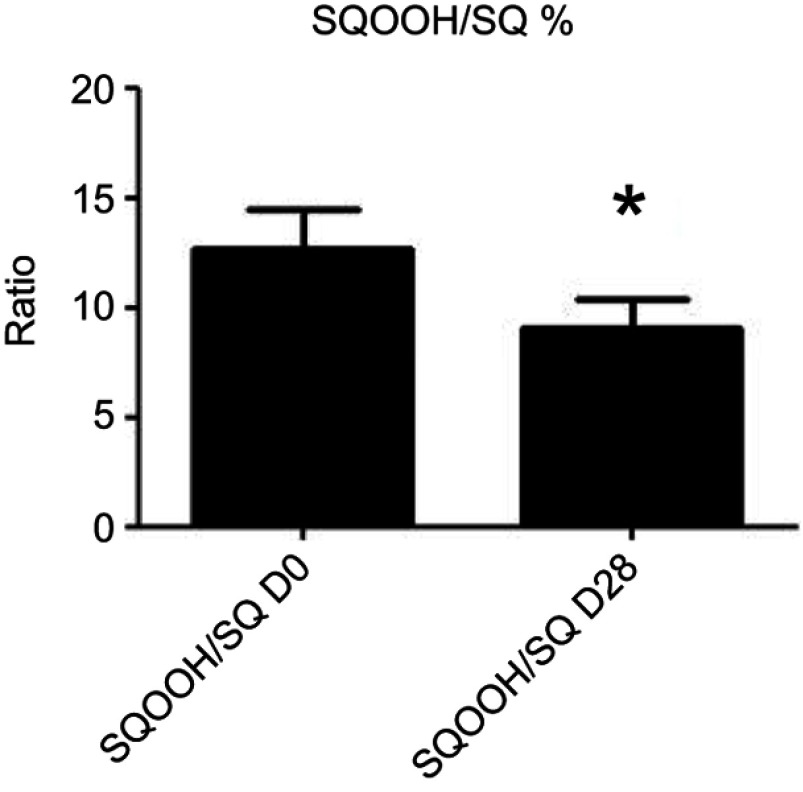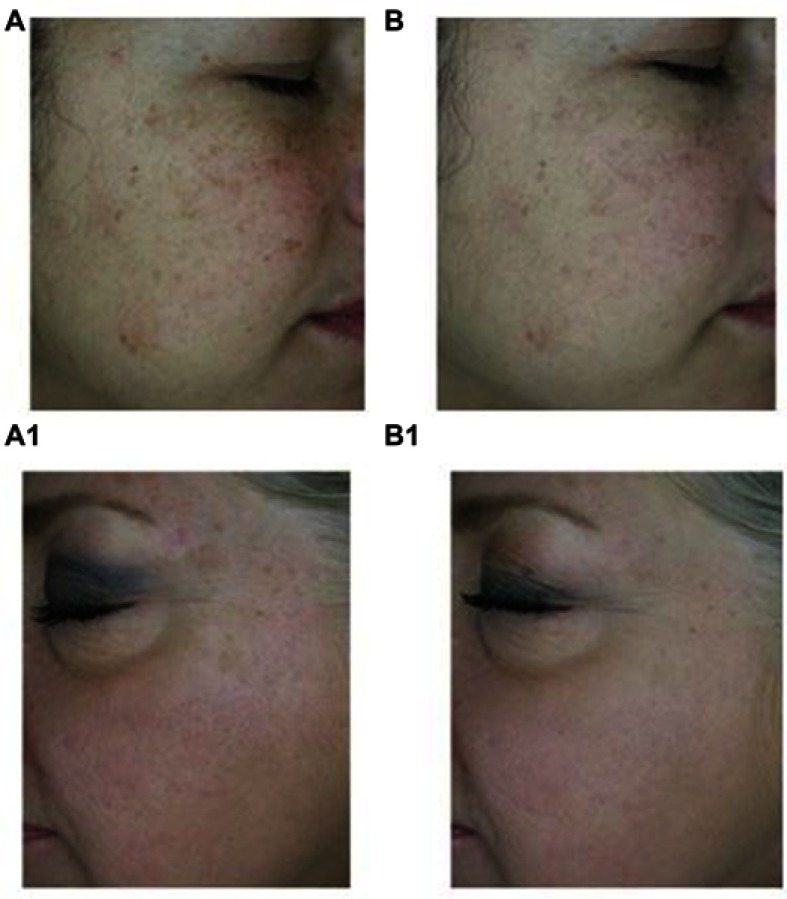Abstract
Introduction: Air pollution causes skin damage and favors skin aging processes such as dark spots and wrinkles, through oxidative stress. Pollutant substances accelerate skin aging through a specific activation of intracellular receptors called AhR (aryl-hydrocarbon receptors). Deschampsia antartica aqueous extract (DAE) has shown to counteract the pollutant-induced AhR activation. Ferulic acid (FA) and vitamin C (VC) are potent antioxidant substances. A serum containing DAE/FA/VC has been recently developed. So far, no clinical data are available regarding the protective actions of this serum against the detrimental effects of air pollution on the skin.
Objective: We conducted a prospective, single-blind, 28-day study to assess efficacy and protective effects against air pollution skin damage of a new serum containing Deschampsia antartica extract.
Materials and methods: Twenty, photo type I–III, women (mean age 42 years) with at least three dark spots on the face, living in a homogenous urbanized, high pollution area (Rome) were evaluated. The objectives of the study were to evaluate the effects of treatment on skin barrier function, assessed by transepidermal water loss (TEWL) measurement (Tewameter), the effect on dark spots, evaluated by means of colorimetry (Colorimeter CL 400), and the effect on squalene peroxide (SQOOH)/squalene (SQ) skin ratio assessed with face swabs.
Results: The trial was conducted between November 20 and December 19, 2018. In comparison with baseline, the product induced a significant improvement of skin hydration (−19% of TEWL), a significant improvement of dark spots (+7%) and a significant improvement of SQOOH/SQ ratio (−16%). The product was evaluated very well by >90% of the treated subjects regarding cosmetic acceptability.
Discussion: A serum containing DAE/FA/VC has shown to improve skin barrier function, to reduce dark spots and to counteract the skin oxidative stress in women living in high pollution urban area.
Keywords: Deschampsia antartica aqueous extract (DAE), air pollution, skin aging, Squalene
Introduction
The skin is an organ in direct contact with various air pollutants.1 Air pollution causes skin damage and favors skin aging processes such as dark spots and wrinkles, through oxidative stress.2 In particular, air pollution causes alteration of skin barrier functions, oxidative stress, and inflammation.3 Skin exposed to pollutants reduces its antioxidative potential.4 Furthermore, pollutant substances, mainly particulate matter (PM10, PM2.5), accelerate skin aging through specific activation of intracellular receptors called AhRs (aryl-hydrocarbon receptors).5 Several studies have demonstrated that AhRs are involved in the pathophysiology of skin, including skin hyperpigmentation, photocarcinogenesis and skin inflammation.6 Deschampsia antartica (DA) is a polyextremophile plant native to Antarctica.7 This plant lives under high solar irradiation, salinity and oxygen concentration, low temperature and extreme dryness.8 DA aqueous extract (DAE) has shown, in vitro, to counteract the pollutant-induced AhR activation.9 Ferulic acid (FA) and vitamin C (VC) are potent antioxidant substances.10,11 The standardized Crypthomphalus aspersa (a snail of the Helicidae family) secretion (SCA), rich in proteins, glycosaminoglycans and antioxidant, is extensively used in cosmetic products as an antiaging and skin regenerating substance.12 A serum containing DAE/FA, VC and SCA (10%) has been recently developed (EC serum). So far, no clinical data are available regarding the protective actions of this serum in vivo against the detrimental effects of air pollution on the skin.
Trial objectives
We conducted an explanatory, experimental, prospective, pilot, single-blind, controlled, 28-day study to evaluate the skin protective effects of EC-serum in women living in urbanized area.
Materials and methods
Subjects
We enrolled 20 women (mean age 42 years) living in a homogenous urbanized, high pollution area (Rome) compelling to spend at least 2 hrs outdoor. The main inclusion criteria were: women aged from 35 to 45 years, with a phototype (Fitzpatrick): I–III, residents in a homogeneous urban area, compelled to spend at least 2 hrs a day outdoors, with at least three dark spots on the face without any other facial skin diseases. During the entire study duration, the volunteers were requested not to use on face any topical products (cosmetics/drugs/medical devices) or sunscreen or any products with an SPF. Table 1 reports subjects’ characteristics at baseline.
Ethical aspects
All the enrolled women gave their written informed consent. The study was performed according to: 1) the general principles of medical ethics in clinical research coming from the Declaration of Helsinki (June 1964) and its successive amendments;13 2) the international recommendations relating to Good Clinical Practices for conducting clinical trials for drugs ICH E6(R1) of 10/06/1996 (CPMP/ICH/135/95);,14 3) the Directive of the European Parliament and Council 2001/20/EC concerning the harmonization of legislative, statutory and administrative provisions of the member States relating to the application of good clinical practices when conducting clinical trials for drugs for human use – OJ/EC of 01/05/2001 and 4) the recommendations of Colipa guidelines, August 1997.15 The study protocol was approved by the Local Ethical Committee. The study was performed at the Institute of Eurofins BioPharma Product Testing, certified ISO 9001:2015 and equipped with material and technical means suitable for noninvasive clinical researches, compatible with the safety requirements for human subjects. The independent Ethical Committee of Eurofins Institute approved the study protocol in October 2018.
Application of DAE/FC/VC serum
The subjects were instructed to apply the tested product (Endocare-C Edafence serum; Cantabria Labs, Madrid, Spain) at home under the normal conditions of use, for 28 consecutive days, on the entire face. The product was applied on the face twice daily (in the morning and in the evening). In particular, specific instructions were given to each subject for the correct application of the tested product: 1) do not wash the face after the application of the serum; 2) do not apply any other skincare products and 3) do not use any make-up products during the study period.
Trial outcomes
The objectives of the study were to evaluate the effects of treatment on skin barrier function, assessed by transepidermal water loss (TEWL) measurements, the effect on dark spots, evaluated by means of colorimetry and the antioxidative protective skin effect evaluating the squalene peroxide (SQOOH)/squalene (SQ) skin ratio assessed by face swabs. TEWL measurements were performed on the face by means of Tewameter TM 300 (Courage & Khazaka, Koln, Germany ) and expressed as g/m2/hr. The evaluation of the dark spots was performed using the Colorimeter CL 400 (Courage & Khazaka) device. This instrument allows evaluating the skin color using the chromatic space L*a*b*. Those data represent the luminance (L*), the quantity of red (a*: red–green axis) and the color intensity (b*: yellow–blue axis) and allow the exact location of each color in the chromatic tridimensional diagram. In this study, to evaluate the intensity of the color of the dark spots, the individual typology angle (ITA°) was considered: ITA°= [arc tangent ((L* - 50)/b*)] 180/3.14159. If the ITA° value increases, the dark spots are lighter. To evaluate the effect on dark spots, high-resolution photographs of the dark spots were performed under standardized lighting with Visioface Quick (Courage & Khazaka). Standardized digital photographs of the full face were taken at D0 and at D28 using the VISIA-CR photo station (Canfield Imaging System, Fairfield, NJ, USA). All these measurements were performed by the same technician, before any application (D0/T0) and then after 28 consecutive days of product use (D28). Serum samples were taken from forehead with a swabbing method at D0 and at D28. Swab homogenates were centrifuged at 10,000 g and subsequently analyzed for squalene monohydroperoxide (SQOOH) and SQ content with liquid chromatography system according to Jourdain et al.16 A specific subjects’ cosmetic qualities and efficacy evaluation questionnaire was also performed at day 28 to evaluate the perceived efficacy by the subjects and the cosmetic acceptability.
Statistical methods
This was a pilot study and therefore a formal calculation of sample size was not performed. Statistical analysis was done using GraphPad statistical software ver. 13.0 (La Jolla, CA, USA). Continuous variables were expressed as mean±SD. The paired Student's t-test and the Wilcoxon tests were used for the analysis of the study outcomes comparing baseline (D0) and D28 values. We calculated also the 95% CIs of the difference in all the variables evaluated. A p-value of <0.05 was considered significant.
Results
Table 1 summarizes the main demographic and clinical characteristics of enrolled subjects. All the enrolled women concluded the 28-day study period. No clinical sign imputable to the investigational product was observed by the investigator during the study. No sensation of discomfort was reported by the subjects during the study. The trial was conducted between November 20 and December 19, 2018. During this period, elevated PM10 concentrations (>20 µg/m3) in the respective urban areas were registered (ARPA official database, Agenzia regionale per la protezione ambientale) in 23 of 29 days. The PM10 average during the study period 35±9 µg/m3. At baseline, the TEWL values were 10.4±2 g/m2/hr. After treatment, TEWL was reduced significantly (P=0.002; Wilcoxon Test) to 8.3±1 g/m2/hr, with an absolute difference of 2.1 (95% CI: 1.3–2.9) (Figure 1). In comparison with baseline, this represents a reduction of −19% in the TEWL mean values. A significant (P=0.01; Wilcoxon test) improvement (decrease in intensity of pigmentation) of dark spots (+7%) was observed after treatment. The ITA° angle at baseline was 23.8±4.4, and it increased significantly to 25.6±5.6 at D28 (P=0.0021; Wilcoxon test), with an absolute difference of 1.7 (95% CI: 0.80–2.7) (Figure 2). A significant improvement of SQOOH/SQ ratio was observed at day 28 in comparison with baseline data (−16%). The SQOOH/SQ ratio at baseline was 12.7±7.6% and 9.0±5.6% after treatment (P=0.017; Wilcoxon test) with an absolute difference of 3.6 (95% CI: 0.40–7.7) (Figure 3). Table 2 reports numerical data analysis for each instrumental parameter. In Figure 4 are presented four high definition pictures of two subjects at baseline and after treatment,l demonstrating the whitening effect on dark spots of the tested serum. These subjects have provided written informed consent for their images to be published. The product was evaluated very well by >90% of the treated subjects regarding cosmetic acceptability. In more detail, 80% of the subjects judged that the product was able to reduce hyperpigmentation; 95% stated that the product made the skin brighter, smoother and softer; 90% of the subjects judged that the product has a good texture and it was easy to apply. No side effects were reported.
Table 1.
Subjects’ characteristics at baseline
| Number | 20 |
|---|---|
| Mean age, years, mean±SD | 42±7 |
| Fitzpatrick photo type, % | I: 0% II:40% III:60% |
| Subjects with sensitive skin, n(%) | 10 (50%) |
| Transepidermal water loss, (TEWL) g/m2/hr, mean±SD | 10.4±2 |
Figure 1.
Evolution of transepidermal water loss (TEWL). *P=0.002; Wilcoxon test.
Abbreviations: TEWL, Trans Epidermal Water Loss; D0, Day zero; D28, Day 28.
Figure 2.
Evolution of dark spots evaluated with colorimetry; *P=0.0021; Wilcoxon test. Abbreviation: ITA, Individual Typology Angle.
Figure 3.
Evolution of SQOOH/SQ ratio. *P=0.017; Wilcoxon test.
Abbreviations: SQOOH, Squalene peroxide; SQ, Squalene.
Table 2.
Data analysis of outcomes variables
| Baseline | Day 28 | Variation and P-value | |
|---|---|---|---|
| Transepidermal water loss (TEWL: g/m2/hr; mean±SD | 10.4±1.99 | 8.3±1.3 | −19.1% (<0.05) |
| Colorimetry (individual typology angle (ITA°); mean±SD | 23.8±4.4 | 25.5±5.6 | +7% (<0.05) |
| Squalene peroxided SQOOH/Squalene SQ % | 12.7±7.6 | 9.0±5.6 | −16% (<0.05) |
Figure 4.
High-resolution pictures of two subjects evaluating dark spots (A and A1: baseline, D0; B and B1: after treatment D28).
Discussion
According to the WHO,17 93% of the population worldwide is exposed to an excessive level of outdoor and/or indoor pollution. Air pollution exposure is associated with premature skin aging, wrinkle formation, pigmented spots, urticaria and eczema.3 Pollutant substances, mainly particulate matter (PM10, PM2.5), cause oxidative stress via the production of ROS and the secretion of proinflammatory cytokines such as TNF, IL-1 and IL-8.18 Furthermore, exposure to air pollutants increases matrix metalloproteinases (MMP) including MMP-1, MMP-2 and MMP-9, with an increase of dermal collagen degradation.19 PM accelerates skin aging through specific activation of intracellular receptors called AhR.20 Air pollution causes alteration of skin barrier functions, oxidative stress and inflammation.21 Exposure to traffic air pollution is related to skin aging in light-skinned women.22,23 Subjects living in high pollution area have a reduced content of SQ in sebum, increased lactic acid levels and altered cohesion of stratum corneum.24 The pollutant substance benzopyrene increases the skin amount of SQOOHs, and this process contributes to skin hyperpigmentation and dark spot formation.25 Pham et al have demonstrated that oxidized SQ is a reliable marker of environmental pollution.26 In our study, we have documented that the use of DAE/FA/VC serum decreases the formation of SQOOHs at skin level, reducing the ratio SQOOX/SQ. SQOOX is considered a secondary mediator of environmental induced stress on the skin.27 SQOOHs induce hyperpigmentation in experimental animal models.28 Several cosmetic products present on the market declare antipollution effects.29 However, it is important that these claims should be validated by specific in vitro and in vivo testing.30 The serum we have evaluated in this trial contains DAE, FA and VC. DAE has shown, in vitro, to reduce the pollutant-induced AhR activation.9 This extract is able also to counteract the detrimental effect of tobacco smoke, heavy metals and oxidant substances on cell viability of cultivated human dermal fibroblasts.31 FA is a potent ubiquitous plant antioxidant, and it can improve the chemical stability of vitamins C.32 Topical VC has a relevant antioxidant and lightening effect.33 In our study, we observed that the 28-day use of DAE/FA/VC serum improves skin barrier function, has a relevant whitening effect on dark spots and reduces the oxidative stress of the skin. Study limitations should be taken into account in evaluating the results of our study. The trial was single-blind; however, the main endpoints of the study were evaluated in an objective investigator-independent manner (TEWL, colorimetry, sebum analysis). In our trial, we did not perform any evaluation of the effect on AhR activity which is problematic in a clinical setting. In addition, the present study was performed during a winter period only, when the main air pollutant substances are PMs. During the summer period, a relevant pollutant is ozone.34 Ozone is an important pro-oxidative substance able to damage skin barrier.35 Future trials, conducted during the summer period, assessing the clinical effects of the tested product could be useful to evaluate the skin protective effect also against this dangerous pollutant substance. The tested serum contains several active compounds (DAEFA, VC and SCA), and therefore it is not possible to discriminate the clinical effects we have observed in this study. The main goal was to evaluate the capability of the serum to protect the skin of subjects living in a high pollution environmental, during a time frame (winter season) characterized by high outdoor pollution (especially PM 10). During the clinical evaluation, high pollution days (PM10 exceeding 20 µ/m3) represented 80% of the entire study period. This further supports the fact that we tested the skin protective effect of this serum under an appropriate time frame for assessing its real antipollution effect.
Conclusion
Short-term use of a serum containing DAE/FA VC and SCA has shown to improve skin barrier function, to reduce dark spots and to counteract the skin oxidative stress in women living in high pollution urban area.
Acknowledgments
Difa Cooper Spa, Cantabria Labs Group, supported this trial with an unrestricted grant.
Author contributions
MP and LC conducted the trial performing visits and instrumental evaluations. MM was involved in study protocol design. All the authors contributed toward data analysis, drafting and critically revising the paper, gave final approval of the version to be published and agree to be accountable for all aspects of the work.
Disclosure
Dr Massimo Milani and Dr Bita Hashtroody are employees of Cantabria Labs Difa Cooper and they, as well as Dr Marco Piacentini, report personal fees from Cantabria Labs Difa Cooper, during the conduct of the study. The authors report no other conflicts of interest in this work.
References
- 1.Brunekreef B, Holgate ST. Air pollution and health. Lancet. 2002;360(9341):1233–1242. doi: 10.1016/S0140-6736(02)11274-8 [DOI] [PubMed] [Google Scholar]
- 2.Drakaki E, Dessinioti C, Antoniou CV. Air pollution and the skin. Front Environ Sci. 2014;2:11. doi: 10.3389/fenvs.2014.00011 [DOI] [Google Scholar]
- 3.Puri P, Nandar SK, Kathuria S, Ramesh V. Effects of air pollution on the skin: a review. Indian Journal of Dermatology. Venereol Leprol. 2017;83(4):415. doi: 10.4103/0378-6323.199579 [DOI] [PubMed] [Google Scholar]
- 4.Wölfle U, Seelinger G, Bauer G, Meinke MC, Lademann J, Schempp CM. Reactive molecule species and antioxidative mechanisms in normal skin and skin aging. Skin Pharmacol Physiol. 2014;27(6):316–332. doi: 10.1159/000360092 [DOI] [PubMed] [Google Scholar]
- 5.Krutmann J, Liu W, Li L, et al. Pollution and skin: from epidemiological and mechanistic studies to clinical implications. J Dermatol Sci. 2014;76(3):163–168. doi: 10.1016/j.jdermsci.2014.08.008 [DOI] [PubMed] [Google Scholar]
- 6.Kim HO, Kim JH, Chung BY, Choi MG, Park CW. Increased expression of the aryl hydrocarbon receptor in patients with chronic inflammatory skin diseases. Exp Dermatol. 2014;23(4):278–281. doi: 10.1111/exd.12350 [DOI] [PubMed] [Google Scholar]
- 7.Romero, MAGDALENA, Casanova AN, Iturra GR et al. Leaf anatomy of Deschampsia antarctica (Poaceae) from the Maritime Antarctic and its plastic response to changes in the growth conditions. Rev Chil Hist Nat. 1999;72:411–425. [Google Scholar]
- 8.Giełwanowska I, Szczuka E, Bednara J, Gorecki R. Anatomical features and ultrastructure of Deschampsia antarctica (Poaceae) leaves from different growing habitats. Ann Bot. 2005;96(6):1109–1119. doi: 10.1093/aob/mci262 [DOI] [PMC free article] [PubMed] [Google Scholar]
- 9.Lucena S, Perez Davò A, Delgado P, Parrado C, Gonzales S, Juarranz A An aqueous extract of Deschampsia antartica (EDA) exerts clear protective effects on human skin cells against dioxin treatment. Poster LB15 30 International Investigative Dermatology Congress May 2018, Orlando (USA). [Google Scholar]
- 10.Graf E. Antioxidant potential of ferulic acid. Free Radical Biol Med. 1992;13(4):435–448. [DOI] [PubMed] [Google Scholar]
- 11.Darr D, Combs S, Dunston S, Manning T, Pinnell S. Topical vitamin C protects porcine skin from ultraviolet radiation‐induced damage. Br J Dermatol. 1992;127(3):247–253. [DOI] [PubMed] [Google Scholar]
- 12.Vitale-Villarejo MA. Efficacy of the intensive treatment with crypthomphalus aspersa secretion (cas) in cutaneous photoaging treatment: P1018. J Am Acad Dermatol. 2007;56(2):AB89. [Google Scholar]
- 13.Schuklenk U. Helsinki declaration revisions. Issues Med Ethics. 2001;9(1):29. [PubMed] [Google Scholar]
- 14.Guideline IH. Integrated addendum to ICH E6 (R1): guideline for good clinical practice E6 (R2). Current Step. 2015;2:1–60. [Google Scholar]
- 15.Ferguson J. European guidelines (COLIPA) for evaluation of sun protection factors In: Cosmetic Science and Technology Series. 1997:513–526. [Google Scholar]
- 16.Jourdain R, Moga A, Vingler P, et al. Exploration of scalp surface lipids reveals squalene peroxide as a potential actor in dandruff condition. Arch Dermatol Res. 2016;308(3):153–163. doi: 10.1007/s00403-016-1623-1 [DOI] [PMC free article] [PubMed] [Google Scholar]
- 17.World Health Organization. Ambient Air Pollution: A Global Assessment of Exposure and Burden of Disease. Geneva, Switzerland: 2016. [Google Scholar]
- 18.Jimenez LA, Drost EM, Gilmour PS, et al. PM10-exposed macrophages stimulate a proinflammatory response in lung epithelial cells via TNF-α. Am J Physiol Lung Cell Mol Physiol. 2002;282(2):L237–L248. doi: 10.1152/ajplung.00024.2001 [DOI] [PubMed] [Google Scholar]
- 19.Ramos C, Cisneros J, Gonzalez-Avila G, Becerril C, Ruiz V, Montaño M. Increase of matrix metalloproteinases in woodsmoke-induced lung emphysema in guinea pigs. Inhal Toxicol. 2009;21(2):119–132. doi: 10.1080/08958370802419145 [DOI] [PubMed] [Google Scholar]
- 20.Krutmann J, Bouloc A, Sore G, Bernard BA, Passeron T. The skin aging exposome. J Dermatol Sci. 2017;85(3):152–161. doi: 10.1016/j.jdermsci.2016.09.015 [DOI] [PubMed] [Google Scholar]
- 21.Valacchi G, Sticozzi C, Pecorelli A, Cervellati F, Cervellati C, Maioli E. Cutaneous responses to environmental stressors. Ann N Y Acad Sci. 2012;1271(1):75–81. doi: 10.1111/j.1749-6632.2012.06724.x [DOI] [PMC free article] [PubMed] [Google Scholar]
- 22.Lefebvre MA, Pham DM, Boussouira B, et al. Consequences of urban pollution upon skin status. Int J Cosmet Sci. 2016;38(3):217–223. doi: 10.1111/ics.12270 [DOI] [PubMed] [Google Scholar]
- 23.Huls A, Vierkotter A, Gao W, et al. Traffic-related air pollution contributes to development of facial lentigines: further epidemiological evidence from Caucasians and Asians. J Invest Dermatol. 2016;136(5):1053–1056. doi: 10.1016/j.jid.2015.12.045 [DOI] [PubMed] [Google Scholar]
- 24.Lefebvre MA, Pham DM, Boussouira B, Bernard D, Camus C, Nguyen QL. Evaluation of the impact of urban pollution on the quality of skin: a multicentre study in Mexico. Int J Cosmet Sci. 2015;37(3):329–338. doi: 10.1111/ics.12203 [DOI] [PubMed] [Google Scholar]
- 25.Abbas S, Alam S, Singh KP, Kumar M, Gupta SK, Ansari KM. Aryl hydrocarbon receptor activation contributes to benzanthrone-induced hyperpigmentation via modulation of melanogenic signaling pathways. Chem Res Toxicol. 2017;30(2):625–634. doi: 10.1021/acs.chemrestox.6b00364 [DOI] [PubMed] [Google Scholar]
- 26.Pham DM, Boussouira B, Moyal D, Nguyen QL. Oxidization of squalene, a human skin lipid: a new and reliable marker of environmental pollution studies. Int J Cosmet Sci. 2015;37(4):357–365. doi: 10.1111/ics.12208 [DOI] [PubMed] [Google Scholar]
- 27.Niki E. Lipid oxidation in the skin. Free Radic Res. 2015;49(7):827–834. doi: 10.3109/10715762.2014.976213 [DOI] [PubMed] [Google Scholar]
- 28.Ryu A, Arakane K, Koide C, Arai H, Nagano T. Squalene as a target molecule in skin hyperpigmentation caused by singlet oxygen. Biol Pharm Bull. 2009;32(9):1504–1509. [DOI] [PubMed] [Google Scholar]
- 29.Whitehouse L. AntiPollution and the Beauty Industry: Part I; Cosmetics Design-Europe.com. West Sussex, UK: William Reed Business Media SAS; 2016. [Google Scholar]
- 30.Rembiesa J, Ruzgas T, Engblom J, Holefors A. The impact of pollution on skin and proper efficacy testing for anti-pollution claims. Cosmetics. 2018;5(1):4. doi: 10.3390/cosmetics5010004 [DOI] [Google Scholar]
- 31.Ortiz-Espin A, de Celix R, Brieva AD, Guerrero A, Gonzalez AS, Sevilla F. The extract of Deschampsia antarctica (EDA) protects fibroblasts viability from the effects of environmental oxidants and pollutants. J Clin Investig Dermatol. 2017;137(5):S124–S124. doi: 10.1016/j.jid.2017.02.743 [DOI] [Google Scholar]
- 32.Murray JC, Burch JA, Streilein RD, Iannacchione MA, Hall RP, Pinnell SR. A topical antioxidant solution containing vitamins C and E stabilized by ferulic acid provides protection for human skin against damage caused by ultraviolet irradiation. J Am Acad Dermatol. 2008;59(3):418–425. doi: 10.1016/j.jaad.2008.05.004 [DOI] [PubMed] [Google Scholar]
- 33.Rendon MI, Gaviria JI. Review of skin‐lightening agents. Dermatol Surg. 2005;31:886–890. [DOI] [PubMed] [Google Scholar]
- 34.Meleux F, Solmon F, Giorgi F. Increase in summer European ozone amounts due to climate change. Atmos Environ. 2007;41(35):7577–7587. doi: 10.1016/j.atmosenv.2007.05.048 [DOI] [Google Scholar]
- 35.Valacchi G, Fortino V, Bocci V. The dual action of ozone on the skin. Br J Dermatol. 2005;153(6):1096–1100. doi: 10.1111/j.1365-2133.2005.06939.x [DOI] [PubMed] [Google Scholar]






